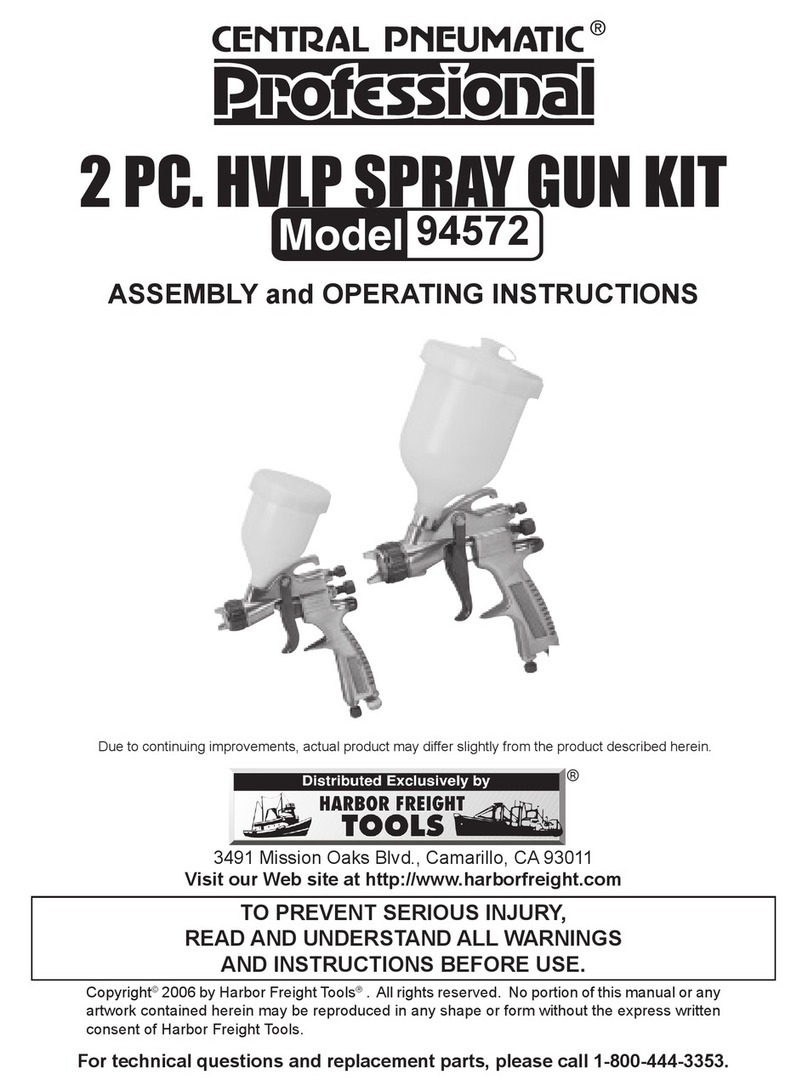SKU 92126 For technical questions, please call 1-800-444-3353. Page 4
Warning: The warnings, cautions, and instructions discussed in this instruction
manual cannot cover all possible conditions and situations that may occur.
It must be understood by the operator that common sense and caution are
factors which cannot be built into this product, but must be supplied by the
operator.
Unpacking
When unpacking, check to make sure the following parts are included.
Mini Detail Spray Gun
Paint Cup with Lid
If any parts are missing or broken, please call Harbor Freight Tools at
the number on the cover of this manual.
Special Warnings About Paint Sprayers
Health and Safety
Hazard Nature and Cause of Hazard Prevention of Hazard
Risk of Explo-
sion or Fire
from Flammable
Materials.
Spraying paints, solvents and thinners mixes
them with oxygen in the air. This creates a
more explosive mixture than these materials
of these mixtures can cause death or severe
-
cal spark or any ignition source. Never smoke
when spraying or in the vicinity of spraying.
Never smoke unless the area has been thor-
oughly aired out. Always provide good ventila-
tion during and after spraying to eliminate any
enclosed explosive atmosphere.
Risk of Fire or
Explosion from
Incompatible
Materials.
Certain solvents, including Methylene Chlo-
ride and 1,1,1-Trichloroethane can chemi-
cally react with with the Aluminum used in
this spray equipment. This can cause an
explosion which may result in death or seri-
ous personal or property injury. Other chemi-
cals, when mixed, may cause unpredictable
results.
Inform yourself by reading the documentation
provided with each solvent before introduc-
ing to the sprayer. Never spray the named
solvents in this sprayer. Never use these
materials for cleaning equipment. Never use
any solvent if in doubt of its composition or
compatibility with Aluminum, other materials
or this spraying equipment.
Inhalation Haz-
ard.
Inhaling solvents or sprayed materials may
cause severe injury to the lungs or body, due
to their chemical make up or the fact that they
may coat the interior of the lungs.
Use an ANSI approved ventilator or face
mask. NOTE: Some face masks, such as
against harmful sprays and fumes. Consult
safety documentation provided with the ma-
terials you are spraying or an industrial safety
expert when determining the appropriate re-
spiratory protection.
Risk of Ejected
Objects or Sonic
Injury.
Many components of this tool and any air
air pressure, even after the air supply is dis-
by ejected components or materials diverted
by the stream of air pressure exists. High
pressure air escaping suddenly may cause
hearing injury.
Before doing any service, inspection, or main-
tenance to the sprayer, dis-connect it from the
air supply. Never point the nozzle toward
any person or animal. Always wear ANSI ap-
proved safety goggles when using or servic-
ing this tool. Always wear hearing protection
when using or servicing this tool or any air
pressure equipment.
Risk of Injection
Injury.
Air powered spray guns operate at high pres-
sures and high ejection velocities. It is pos-
sible for sprayed material to be injected into
the skin, which can result in serious personal
injury. Highly pressurized sprays may dam-
age property or injure persons.
Never point or spray toward any person or an-
part of your body in front of the spray nozzle
if the spray gun is not disconnected and de-
pressurized. Test spray on scrap material be-
fore spraying work material.
































